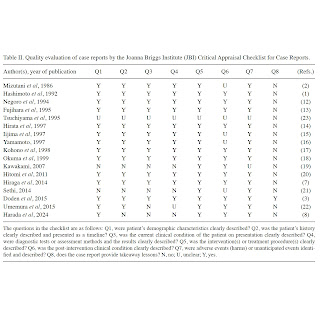Article type: Literature Review
Article title: Transient myoclonic state or transient myoclonic state with asterixis: A systematic review
Journal: Medicine International
Year: 2025
Authors: Jamir Pitton Rissardo, Nilofar Murtaza Vora, Nirali Seth, Sanobar Shariff, Ana Letícia Fornari Caprara
E-mail: jamirrissardo@gmail.com
ABSTRACT
Transient myoclonic state (TMS) is a rare type of myoclonic jerks occurring predominantly in the upper extremities involving the head and commonly associated with asterixis. The present study performed a systematic review of published articles on this condition. For this purpose, six databases were searched by two reviewers to identify reports on TMS published online until November, 2024. A total of 17 reports containing 78 cases were found. Almost all the reports were from Japan, apart from one case reported in the USA. The mean age of the patients was 75.67 years (standard deviation, 5.8 years) and the median age was 75 years (range, 54 to 84 years). Sex was reported in 74 reports, and 60.8% of the patients were males. A precipitating factor, such as an infectious disease or the introduction of a new medication was observed in 24 cases (30.7%). All individuals achieved full recovery; however, 53 patients (67.9%) required benzodiazepine therapy, while the remaining individuals improved spontaneously. In summary, the present systematic review demonstrates that TMS is a rare condition, and is mainly encountered in Japan by unknown factors. There are likely genetic and environmental factors involved in its development; however, no specific geolocation related to the occurrence of TMS in Japan was found. It has a benign course and usually improves with the prescription of benzodiazepines. Management strategies include ensuring adequate multidisciplinary care coordination, as well as educating patients and their families about TMS. Future studies are required to describe the cases of TMS, including videos of the phenomenology. It is also recommended to perform whole genome sequencing analysis in patients with TMS..
Keywords: transient myoclonic state; myoclonus; transient myoclonic state with asterixis; transient co‑occurrence of myoclonus; asterixis.
Full text available at:
DOI
Citation
Rissardo J, Vora NM, Seth N, Shariff S, Fornari Caprara AL. Transient myoclonic state or transient myoclonic state with asterixis: A systematic review. Med Int 5: 29, 2025. https://doi.org/10.3892/mi.2025.228.
Figure 1. Flowchart of the study screening process for the present systematic review.
Figure 2. Geographical distribution in Japan of the cases reported in the literature of transient myoclonic state. The case described in the study by Sethi (21) was not included as it was outside Japan. In addition, there were insufficient data from the study by Tsuchiyama et al (23) to provide the geographical localization. The locations are indicated by numbers on the map and refer to the following studies: 1, Mizutani et al (2); 2, Hashimoto et al (1); 3, Negoro et al (12); 4, Fujihara et al (13); 5, Hirata et al (14); 6, Iijima et al (15); 7, Yamamoto (16); 8, Kohono et al (17); 9, Okuma et al (18); 10, Kawakami (19); 11, Hitomi et al (20); 12, Hiraga et al (7); 13, Doden et al (3); 14, Umemura et al (22); 15, Harada et al (8).
Table I. Free text and medical subject heading search terms used in the US National Library of Medicine.
Table II. Quality evaluation of case reports by the Joanna Briggs Institute (JBI) Critical Appraisal Checklist for Case Reports.
Table III. Literature review of reports of transient myoclonic state.
Table IV. Transient myoclonic state features (as indicated in the manuscript).





